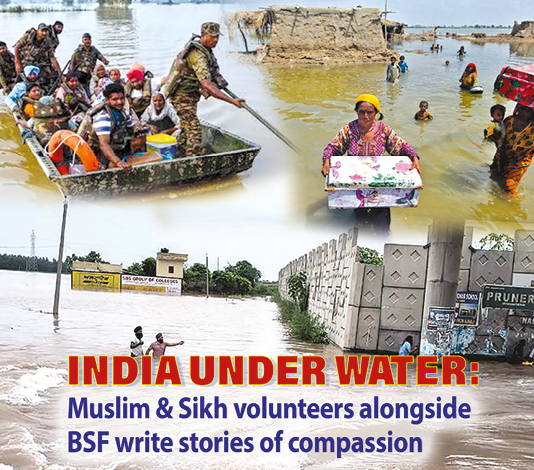2025-Floods, Faith, and the Fight for Resilience
– Dr. M. Iqbal Siddiqui, Delhi
In Punjab’s flood-ravaged villages, where the Ravi River turned homes into islands from 22 August 2025, stories of compassion rose above the waters. In Dhangai, Gurdaspur, Indian Army sappers from the Kharga Corps rescued a Hindu mother and her 15-day-old baby, stranded on the first floor of a submerged house. With improvised ladders and boats, the Sikh soldiers carried the family to safety – an act of courage that transcended identity.
Not far away in Ajnala, Sikh volunteers of Khalsa Aid waded through chest-deep waters to deliver food, blankets, and supplies. Supported by Punjabi singer Satinder Sartaaj, who donated rations for 500 families, they reached out to Hindus, Muslims, and Sikhs alike – reminding all that in times of disaster, need outweighs religion. At several relief points, Jamaat-e-Islami Hind (JIH), working alongside the Border Security Force (BSF), distributed essentials and rescued stranded people. JIH pledged long-term rehabilitation, including medical aid, legal help, counselling, and employment support. “We are committed to stand with victims until normalcy is restored,” affirmed Maulana Shafi Madani of JIH after visiting the flood-hit areas. Abdul Shakoor, a JIH office bearer, highlighted the plight of a girl who lost her mother and three siblings. “She is in mental shock, unable to speak, and there are many like her who need urgent counselling and support,” he said.
Further south in Rajasthan’s Sawai Madhopur, where the Chambal overflowed and engulfed hundreds of villages, humanity again prevailed: Hindu farmers and Muslim neighbours risked their lives together to save a Muslim family trapped in their flooded home.
Set against one of India’s worst floods in decades, these vignettes reveal a simple truth – when calamity strikes, compassion rises higher than the water, washing away barriers of faith and geography.
A Catastrophe Unfolds: Humanity Triumphs
Punjab: From 22 August 2025, Punjab saw its worst floods in nearly four decades, submerging 2,092 villages across 23 districts. More than 387,000 people were displaced, 51 lives lost, and crops worth over ₹3,000 crore destroyed across 184,000 hectares – crippling India’s “food basket.” Paddy, cotton, and sugarcane rotted, livestock drowned, and rural economies collapsed. Infrastructure losses included stretches of Indo-Pak border fencing, BSF posts near the Kartarpur Corridor, and major road and power networks. Over 2,000 relief camps were established, supported by NDRF, SDRF, BSF, and Army teams using boats and helicopters for rescues.
Rajasthan: In Sawai Madhopur, the Soorwal Dam overflowed, gouging a massive crater in Jadawata village and inundating nearby settlements. More than 11 people died, hundreds of homes were submerged, and 40% of crops and orchards across 22 villages were lost. Farmers like Kamal Meena of Rawal Gram Panchayat and Abdul Bari of Soorwal reported total devastation. JIH responded with ₹6.37 lakh in relief – cash, rations, cooked food, and medicines – while pressing the state for urgent compensation.
Gujarat and Other States: In Saurashtra and Kutch, floods in over 100 talukas caused damages nearing ₹10,000 crore, with cotton and groundnut crops ravaged, reservoirs overflowing, and bridges collapsing. Uttarakhand, Himachal Pradesh, and Jammu & Kashmir battled flash floods and landslides, while Assam faced parallel crises. Nationally, millions of hectares were inundated, threatening food security, spiking rice prices, and disrupting cotton exports – damages running into billions. Assessments are still underway.
Politics, Water, and Mismanagement
Beyond human stories, questions of policy and dam management demand scrutiny. The 2025 floods were not just a story of rainfall – they were shaped by governance failures and geopolitical rifts.
For years, Punjab accused the Bhakra Beas Management Board (BBMB) of releasing dam waters without warning. But in 2025, the spotlight shifted to the Ranjit Sagar Dam – run by Punjab’s own irrigation and power departments.
By 25 August, the reservoir had swelled dangerously, touching its maximum permissible level of 527.91 metres as rains poured in from Himachal Pradesh and Jammu & Kashmir. With no buffer left, gates were opened, unleashing more than two lakh cusecs into the Ravi. Downstream, the Madhopur barrage groaned under the pressure. Two gates snapped, embankments broke, and the river tore through Gurdaspur’s villages. The Ujh River joined in with its own surge, amplifying the disaster.
Even when the countryside lay submerged, the dam continued to disgorge vast volumes – over one lakh cusecs on 29 August, and still 42,000 two days later, prolonging misery. Officials defended themselves, citing dam safety.
Elsewhere, the Bhakra and Pong dams handled heavier inflows with moderated releases. “We handled the unprecedented water carefully, and with the consent of all states,” explained BBMB Chairman Manoj Tripathi. But such reassurances meant little to farmers like Harjit Singh of Gurdaspur, who stood among flattened fields and washed-out homes: “Our homes and crops were washed away by Ravi waters, but no one is questioning Ranjit Sagar.”
The Indus Waters Treaty in Abeyance
The floods also wreaked havoc across the border in Pakistan’s Punjab, where more than 2 million people were affected, hundreds lost lives, and 1,400 villages went under water. The suspension of data sharing under the Indus Waters Treaty (IWT) in April 2025, following a terror attack in Kashmir, meant Pakistan no longer received flood-related information on the Ravi, Sutlej, and Beas rivers. Pakistani officials alleged that sudden releases from Indian dams worsened the crisis, while Indian authorities denied deliberate action, pointing instead to climate-driven rainfall.
Without IWT’s structured mechanisms, Pakistan’s flood monitoring capacity came under strain. Experts such as Daanish Mustafa stressed that climate change was the real driver, but the pause in treaty mechanisms – remarkable given the IWT’s survival through past wars – added an extra layer of vulnerability.
Within India, Punjab’s reluctance to release water for Rajasthan and Gujarat, driven by irrigation disputes, led to abrupt releases flooding Sawai Madhopur and Baran. Inter-state coordination faltered, with no real-time data shared via BBMB or Upper Yamuna Board.
Faith in Action: Aid Without Boundaries
While governments struggled, civil society stepped in with remarkable compassion. In Punjab, Khalsa Aid delivered food, fodder, and essentials in flood-hit areas like Sangra, Baupur Jadid, Sunder Chuck, Kolia, and Sindhupur, where 30 concrete houses were washed away and four lives lost, including three siblings and their grandmother. Supported by Punjabi singer Satinder Sartaaj, Khalsa Aid reached Hindus, Muslims, and Sikhs, embodying service beyond faith.
JIH, led by Maulana Shafi Madani, visited these villages alongside Sikh community leaders, distributing food kits, medicines, blankets, and other essentials in collaboration with the Society for Bright Future. JIH also laid out plans for medical aid, legal help, counselling for trauma survivors, and employment support. “We are extremely concerned about the hardships of flood victims. Along with our partners and the BSF, we are committed to providing food, shelter, healthcare, and rehabilitation until normalcy is restored,” said Maulana Madani.
In Sawai Madhopur, JIH provided ₹377,000 to 121 households, 500 ration kits, 350 cooked food packets, and medicines, totalling ₹637,000. JIH’s president, Syed Sadatullah Husaini, appealed for national support for flood-hit communities across states.
Government’s Role and Shortcomings
Punjab CM Bhagwant Mann declared all 23 districts flood-hit, deploying SDRF, one state helicopter, and 2,019 relief camps for 387,000 displaced people. Rajasthan CM Bhajan Lal Sharma mobilised the Army in Sawai Madhopur and Baran, closed schools till September 7, and sent ₹5 crore aid to Uttarakhand. Gujarat CM Bhupendra Patel evacuated 18,000 with NDRF/SDRF teams. The Centre deployed 23 NDRF teams, 12 army columns, two engineer units, and 30-35 helicopters, evacuating nearly 15,000.
Yet, delays in IMD’s warnings, Ranjit Sagar Dam’s mismanagement, and weak inter-state coordination drew criticism. Punjab officials defended RSD releases, but BBMB’s cautious approach highlighted lapses. Gujarat’s outdated drainage and ignored floodplain zoning worsened urban flooding. NDMA’s underestimation of September rains exposed systemic gaps.
Revive, Safeguard, Survive
The 2025 floods – from Punjab to Rajasthan, Gujarat, and beyond – exposed a dual truth: climate extremes are intensifying, while governance falters. Cloudbursts, glacial melt, urban encroachment, and erratic dam operations magnified the havoc of surplus rainfall.
Yet amidst loss, humanity prevailed: Sikh soldiers rescuing a Hindu mother and child, Khalsa Aid volunteers serving across faiths, and Jamaat-e-Islami Hind pledging rehabilitation with Sikh leaders. Farmers saving neighbours of another faith showed disaster can dissolve division.
But compassion cannot replace policy. India and Pakistan must rethink cooperation under the Indus Waters Treaty, strengthen real-time data sharing, and adopt modern dam management. At home, reservoir moderation, floodplain zoning, and community readiness are essential.
A way forward lies in an EPIC framework: Enable communities, Plan resilient infrastructure, Invest in forecasting and technology, and Control reckless encroachments. The rivers will not wait – only science, solidarity, and accountability can turn future floods from tragedies into resilience.




